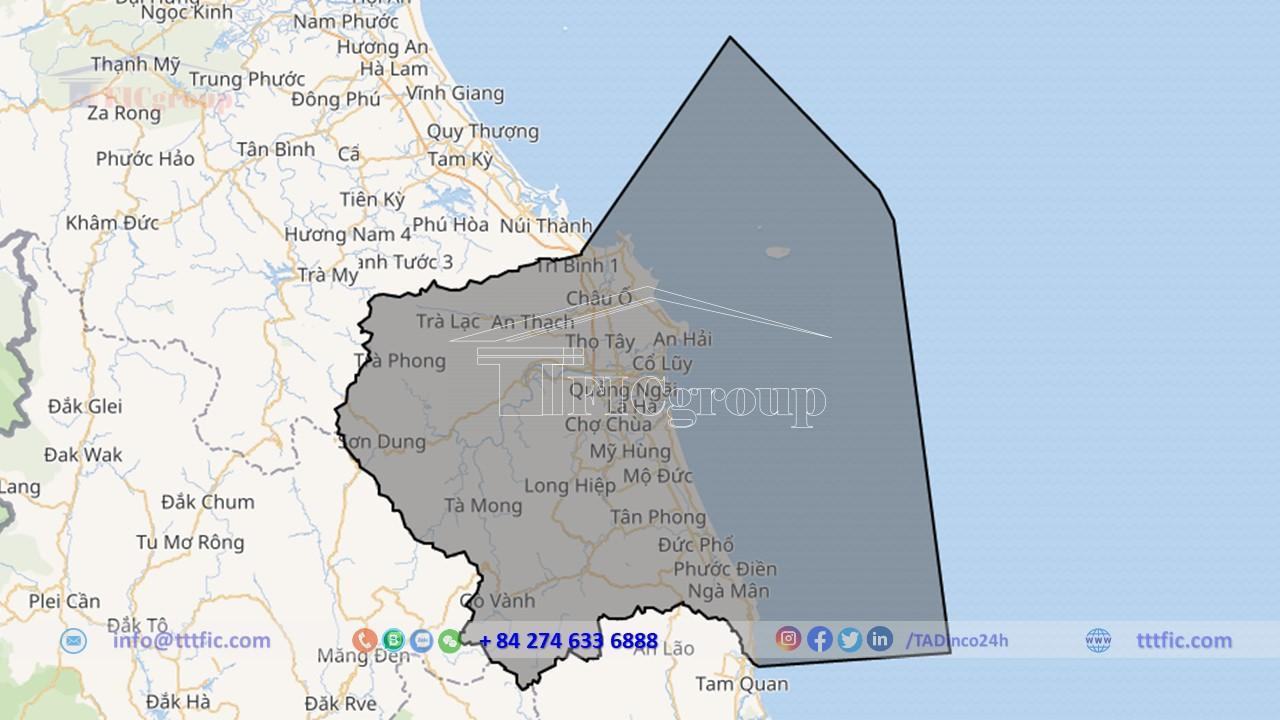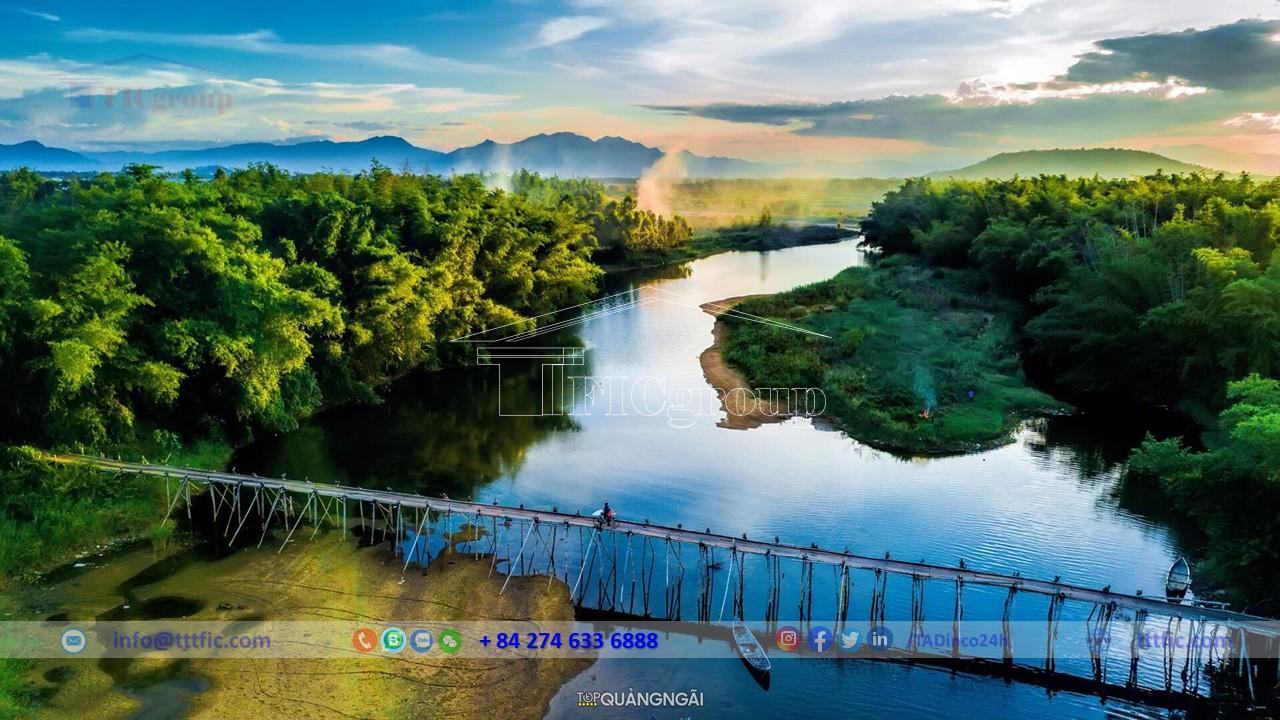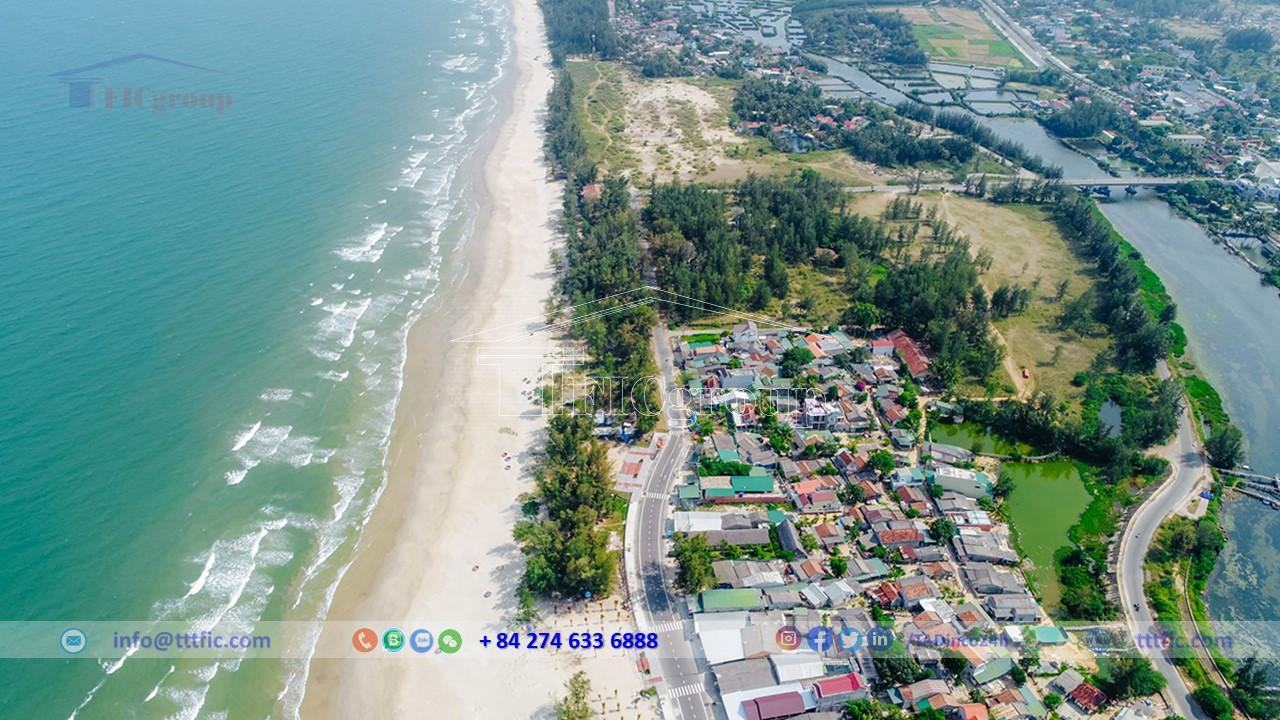Quang Ngai Province, a coastal province in the South Central Coast region of Vietnam, is known for its beautiful beaches. Its capital is Quang Ngai City, located 820 km south of Ho Chi Minh City, 146 km north of Da Nang, and 908 km north of Hanoi via National Highway 1.
In 2018, Quang Ngai ranked 19th in population, 27th in Gross Regional Domestic Product (GRDP), 20th in per capita GRDP, and 13th in GRDP growth rate among Vietnamese administrative units. With a population of 1,272,800, the GRDP reached 73,568 billion VND (equivalent to 3.1951 billion USD), per capita GRDP stood at 57.8 million VND (equivalent to 2,510 USD), and the GRDP growth rate was 9.60%.
The coastline of Quang Ngai stretches approximately 129 km, encompassing a vast territorial sea of 11,000 km2 and six resource-rich coastal areas with beautiful beaches. Quang Ngai is part of the key economic region in the South Central Coast, chosen by the government to establish Vietnam’s first oil refinery in Dung Quat (Binh Son – Quang Ngai). The province was reestablished on July 1, 1989, by separating from Nghia Binh Province and forming two separate provinces, Quang Ngai and Binh Dinh.
Quang Ngai province consists of one centrally-governed city (Quang Ngai City), one town (Duc Pho), and 11 districts, including one island district (Ly Son), five lowland districts, and five mountainous districts. The districts of Quang Ngai are Ba To, Binh Son, Minh Long, Mo Duc, Nghia Hanh, Son Ha, Son Tay, Son Tinh, Tra Bong, and Tu Nghia.
Geography of Quang Nam Province:
Geographical location:
Quang Ngai province stretches from 14°32′N to 15°25′N, 108°06′E to 109°04′E, leaning against the Truong Son mountains. Quang Ngai borders the East Sea in the east with a coastline of 144 km. It shares a 98-km border with Quang Nam province in the north, an 83-km border with Binh Dinh province in the south, a 79-km border with Kon Tum province in the west, and about a 10-km border with Gia Lai province in the southwest. It is in the middle of Vietnam, 884 km north of Hanoi and 836 km south of Ho Chi Minh City via National Highway 1.
Natural condition:
Quảng Ngãi’s geography, complex yet gradually lowering from west to east, incorporates hills, coastal plains, and the eastern slope of the Truong Son mountains. Low mountains and hills intermix with plains in some areas, running close to the sea. The province experiences a tropical climate and monsoon winds, maintaining high, steady temperatures. With an average temperature of 25-26.9°C, it enjoys abundant light and rainfall. It clearly differentiates into a rainy season and a dry season.
The province’s soil classifies into nine main groups, further divided into 25 primary and 68 secondary soil units. These include sand dunes, coastal sands, saline soil, alluvial soil, gy soil, gray soil, yellow-red soil, black soil, cracked soil, and eroded rocky soil. Gray soil dominates, covering over 74.65% of the natural land, suitable for perennial industrial crops, specialty crops, medicinal plants, and livestock. Alluvial soil, found in the lower reaches of rivers and making up 19.3% of the natural land, suits rice cultivation, short-term industrial crops, and legumes. Quảng Ngãi’s soil, light and slightly compact, is apt for sugarcane and short-term industrial crops.
Economy of Quang Ngai province:
Agriculture:
Agricultural production in the first 9 months of 2022 had some fundamental advantages. The irrigation system, including canals and reservoirs, was upgraded to ensure stable and effective irrigation for crops. There was close coordination and guidance between relevant agencies and authorities at different levels. The transfer of scientific and technical knowledge to farmers was timely through agricultural promotion programs and technical training. Most localities and farmers strictly followed the recommended seasonal schedule and made necessary preparations for production.
However, agricultural production faced challenges due to complex weather patterns, impacting the yield and output of certain crops. Specifically, during the early spring crop of 2022, widespread flooding caused by storms and cold air surges damaged significant areas of rice and flowers, requiring multiple reseeding. Towards the end of the season, heavy rainfall led to further flooding and lodging of mature rice, resulting in significant losses in yield and output. The development and expansion of crop restructuring models still faced limitations, market prices remained unstable, and the linking of value chains between agricultural businesses and farmers had constraints, hindering the expansion of such models.
Crop:
The annual cultivated area for the winter-spring crop reached 61,195.9 hectares, an increase of 1.2% (705 hectares) compared to the previous year. Among them, the area for cultivating grain crops was 42,891.6 hectares, a 0.6% increase (261.8 hectares) compared to the previous year. The grain crop yield reached 258,870.4 tons, a decrease of 4.2% (11,399.4 tons).
The cultivated area for the summer-autumn crop reached 52,259.3 hectares, an increase of 2.6% (1,334.9 hectares) compared to the previous year. Among them, the area for cultivating grain crops was 39,706.4 hectares, a 3.3% increase (1,282.3 hectares) compared to the previous year. The grain crop yield reached 227,703.6 tons, a 2.7% increase (5,312.6 tons).
The increase in the cultivated area for the summer-autumn crop this year was mainly due to some areas that lacked irrigation water in the previous year, leading to farmers leaving the land uncultivated. This year, with more favorable weather conditions and sufficient irrigation water, cultivation resumed. Additionally, some areas returned to cultivation after the completion of water reservoir projects in Binh Son district.
The livestock production in the first 9 months of 2022 showed positive changes.The pig farming sector is gradually recovering, effectively controlling African swine fever. However, the breeding process is slow due to a shortage of breeding stock.. Poultry farming is developing strongly. The buffalo and cattle population decreased slightly compared to 2021 due to the impact of foot-and-mouth disease.
As of September 30, 2022, the livestock population in the province is as follows:
– The buffalo population reached 67,657, a 1.6% decrease compared to the same period in 2021. During the 9 months, 10,218 buffaloes were sold, a 2.6% increase compared to the same period in 2021. The pork production reached 2,828.15 tons, a 3.2% increase.
– The cattle population reached 282,855, a 0.4% decrease compared to the same period in 2021. During the 9 months, 74,334 cattle were sold, a 2.5% increase. The beef production reached 16,026.59 tons, a 3.3% increase compared to the same period in 2021. At the Vinamilk dairy farm in Mo Duc, there are 4,053 dairy cows, a 35.7% increase compared to the previous year. The milk production for 9 months reached 12,485.7 tons, a 775.4% increase.
– The pig population reached 378,852, a 2.5% increase compared to the same period in 2021. During the 9 months, 538,694 pigs were sold, a 3.0% increase. The total weight of pigs sold reached 35,175.95 tons, a 3.8% increase.
– The poultry population reached 5,879.64 thousand, a 1.0% increase compared to the same period in 2021, mainly due to the increase in chicken population. The poultry meat production reached 12,041.43 tons, a 5.0% increase.
– The egg production for 9 months reached 90,339.19 thousand, a 10.0% decrease compared to the same period in 2021.
Forest:
Forest planting activities continued during the month due to rainfall. An estimated 2,553.3 hectares of forests were planted, a 4.1% increase compared to the same month in 2021. For the first 9 months, the total area of planted forests reached 12,427.1 hectares, a 5.5% increase compared to the same period last year.
The timber production in September was estimated at 208,712.3 cubic meters, a 7.7% increase (15,000 cubic meters) compared to September 2021. For the first 9 months of 2022, the estimated timber production reached 1,543,758.4 cubic meters, a 5.3% increase (77,768.2 cubic meters) compared to the same period last year.
In the first 9 months of 2022, forestry activities included 463 suppression campaigns, 648 inspections, and 2,421 management and protection patrols. As a result, 182 violations were detected, resulting in the seizure of 87.0 cubic meters of round timber and 110.25 cubic meters of processed timber. The budget revenue amounted to 1,678,349,500 VND, a decrease of 382,992,500 VND compared to the same period in 2021 (2,061,342,000 VND in 2021).
Aquaculture:
In the first 9 months of 2022, aquaculture activities remained stable, with a 1.3% increase in total aquaculture production compared to the same period in 2021. Extraction of aquatic products increased by 1.4%, while aquaculture production decreased by 2.7%.
During September, extraction reached 23,639.5 tons, a 2.6% increase compared to September 2021. For the first 9 months, extraction amounted to 228,256.2 tons, a 1.4% increase. The increase in extraction was attributed to improved fishing activities and increased vessel capacity.
The total area of aquaculture in the province for the first 9 months of 2022 was estimated at 1,878.3 hectares, a 0.5% increase. Shrimp farming decreased by 7.9% to 776.7 hectares, while fish farming decreased by 0.4% to 927.8 hectares. However, other types of aquaculture experienced a significant increase of 86.8% in the estimated area.
Total aquaculture production for the first 9 months of 2022 was estimated at 6,285.3 tons, with shrimp production reaching 3,980.5 tons, a decrease of 8.6%. Fish production increased by 2.7% to 1,492.4 tons, while other aquaculture production increased by 25.6% to 812.3 tons.
There were cases of shrimp diseases, including acute hepatopancreatic necrosis disease (AHPND) and white spot syndrome, affecting 6.6 hectares of shrimp farming areas. Additionally, red spot disease occurred in fish at the Làng Dam in Hành Tín Tây commune, Nghĩa Hành district.
Industry:
Industrial production in the province maintained its growth momentum in the first 9 months, with several sectors experiencing high growth rates. The metal manufacturing sector and the coke and refined petroleum products sector continued to contribute significantly to overall industrial production growth. Market demand has shown signs of recovery and stability, prompting enterprises to be more proactive in labor and production planning, overcoming challenges, and expanding production.
By the end of September, industrial activities in the province continued to exhibit positive signs. The cumulative labor utilization index for the first 9 months increased by 26.64% compared to the same period last year. The cumulative consumption index of processed and manufacturing industries increased by 11.92% compared to the same period last year, while the inventory index as of September 30, 2022, decreased by 30.64% compared to the same period last year. Most of the secondary industries within the processing and manufacturing sector have recovered production, with 11 out of 14 industries showing increased production compared to the same period last year. Two major products, namely petroleum refining products (increased by 293,475 tons) and iron and steel products (increased by 35,383 tons), contributed to the significant growth of industrial production in the first 9 months (an increase of 8.17%).
Social:
Residential:
As of April 1, 2019, Quang Ngai province had a population of 1,231,697 with a density of 237 people/km². The urban population comprised 16.3% (201,019 people), while the rural population was 83.7% (1,030,678 people). The male population was 611,914 and the female population was 619,783. The natural increase rate was 0.12 ‰ and the urbanization rate was 30% by 2022.
According to the General Statistics Office of Vietnam, as of April 1, 2009, Quang Ngai was home to 29 ethnic groups, including foreigners. The Viet ethnicity was the most populous with 1,055,154 people, followed by the Hre (115,268 people), the Co (28,110 people), the Xo Dang (17,713 people), and other ethnicities such as Chinese, Muong, Tay, Thai.
As of April 1, 2019, there were 10 different religions in Quang Ngai, totaling 70,454 believers. The most practiced was Protestantism (31,996 people), followed by Buddhism (23,220 people), Catholicism (9,226 people), and Caodaism (6,000 people). Other religions like Islam, Hoa Hao Buddhism, Brahmanism, and the Vietnamese Buddhist Association each had a few followers, with Buu Son Ky Huong and Bahá’í each having one follower.
Education:
As of June 30, 2012, the number of schools in Quang Ngai province recognized as meeting national standards were 23/206 kindergartens, 121/224 primary schools, 63/165 lower secondary schools, and 13/39 high schools. The plan for universal kindergarten for 5-year-olds achieved 97% completion.
As of September 30, 2011, Quang Ngai province housed 437 schools including 35 high schools, 166 lower secondary schools, 222 primary schools, 4 middle schools, and 10 basic schools, along with 210 kindergartens. This educational system contributes to literacy improvement in the province.
Quang Ngai’s higher education system comprises:
– Pham Van Dong University (under Quang Ngai People’s Committee);
– University of Finance and Accounting (under the Ministry of Finance);
– Ho Chi Minh City University of Technology Quang Ngai branch (under the Ministry of Industry and Trade).
The province also houses several colleges, including:
– Dang Thuy Tram Medical College;
– Dung Quat Technology College;
– Vietnam-Korea College;
– Quang Ngai College;
– Mechanical Vocational College;
– Ho Chi Minh City Industry and Trade College, Quang Ngai branch.
Notably, Quang Ngai boasts the IEC (International Education City) with its modern infrastructure and high internationalization philosophy.
The province also includes several vocational secondary schools.



